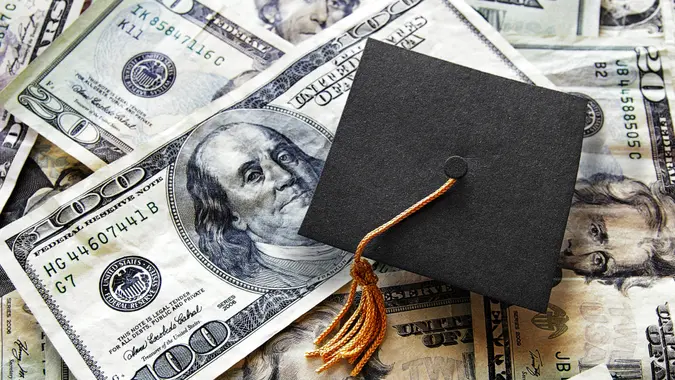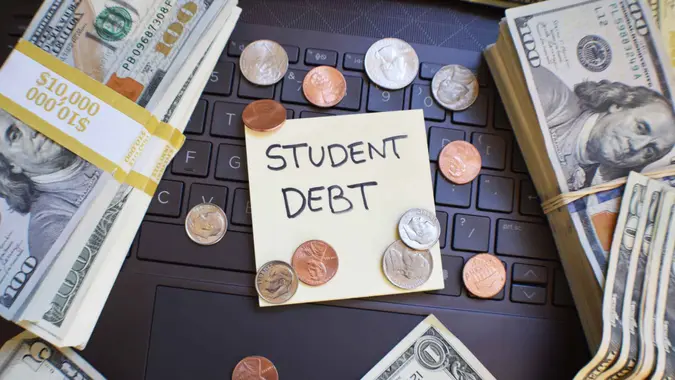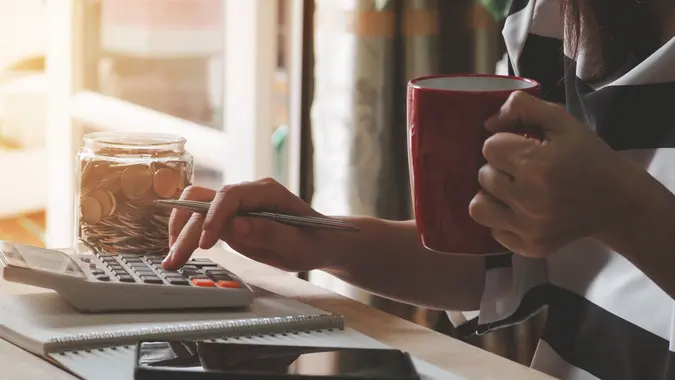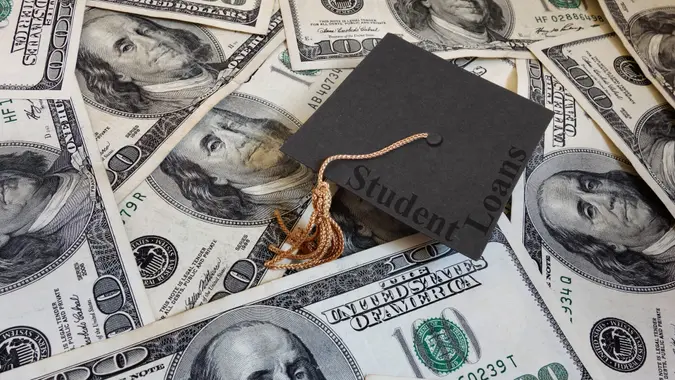Student Loan Payments: 4 Expert Tips on Paying Bills Outside of Your Budget

Commitment to Our Readers
GOBankingRates' editorial team is committed to bringing you unbiased reviews and information. We use data-driven methodologies to evaluate financial products and services - our reviews and ratings are not influenced by advertisers. You can read more about our editorial guidelines and our products and services review methodology.

20 Years
Helping You Live Richer

Reviewed
by Experts

Trusted by
Millions of Readers
Student loan payments resumed last October for the first time in three years, following the Supreme Court’s striking down — in a 6-3 decision — of President Joe Biden’s student loan relief program on June 30, 2023.
This has taken a toll on millions of Americans’ budgets and now, 13% of consumers with student loans said they did not plan on making payments, according to a TransUnion study.
According to the Education Data Initiative, the average monthly student loan payment stands at $503. And according to a TransUnion July study, consumers will experience what it deems “payment shocks,” as 50% of them are expected to have a payment of more than $200 a month, while about one in five will see payments of more than $500.
According to Peter C. Earle, senior economist, American Institute for Economic Research, this is taking place against a backdrop of financial strain stemming from ongoing inflation pressures, which serves as an accelerant.
“The major way to pay bills outside of one’s budget is to sacrifice consumption elsewhere,” he said. “It’s difficult to do, but a bit easier with consumer prices still rising at twice the Fed’s target rate and credit card rates near all-time highs.”
While balancing these new bills might be tricky for many, here’s expert advice for paying bills outside your budget.
Put a Budget in Place
First, it is crucial to make sure you have a current, written budget.
“It’s one thing to say that something ‘doesn’t fit into the budget,’ it’s another to actually have taken the time to put one together,” said Kyle Enright, president of Achieve. “That is really the only way to know exactly what is coming in and going out. And there are some very good budgeting apps now available.”
If going this route, Enright recommended selecting one that connects all financial accounts, automatically tracks past and current spending, and predicts how much money left over you are expected to have each month.
Cut Back
Enright said that you can find countless tips on how to save on utilities, gas, household expenses and more online.
“A good way to start the expense-cutting effort, though, is to figure out what your expenses are, how you spend your money and how you can cut back,” he said, also noting that your situation will be unique and not like your friends’ or neighbors’.
In addition, he said you should try to make the effort to keep every single receipt for every single purchase over a period of a couple of weeks.
“Most people find some surprises in where their money actually goes,” he said. “From there, you can make informed decisions on what expenses you might be able to cut.”
Assess Your Financial Situation
As Enright further argued, if you’ve taken these steps and determined there is no way you can afford to pay your student loan bill — or other essential bill — you have to face the fact that you don’t have enough income.
“To address this not-uncommon situation, many people are developing side gigs to generate additional income,” he said, conceding that while it may not be easy and won’t be for everyone, it is an option for many that can lead to many long-term benefits.
For instance, Enright said that retail and food service companies offer very good hourly rates for flexible part-time.
Find a Program to Pay Down Debt
Many people who can’t find money to pay bills are carrying too much debt and already struggling to make those payments.
According to Enright, if you are in this situation and can’t pay down your debt on your own, use the avalanche or snowball strategy. Other options include looking into a balance transfer, personal loan or debt consolidation loan.
“If you are really struggling, unable to make minimum payments on your debts as a result of a true financial hardship, debt resolution (settlement) may be an option to lower principal balances due,” he said.
 Written by
Written by  Edited by
Edited by 
























